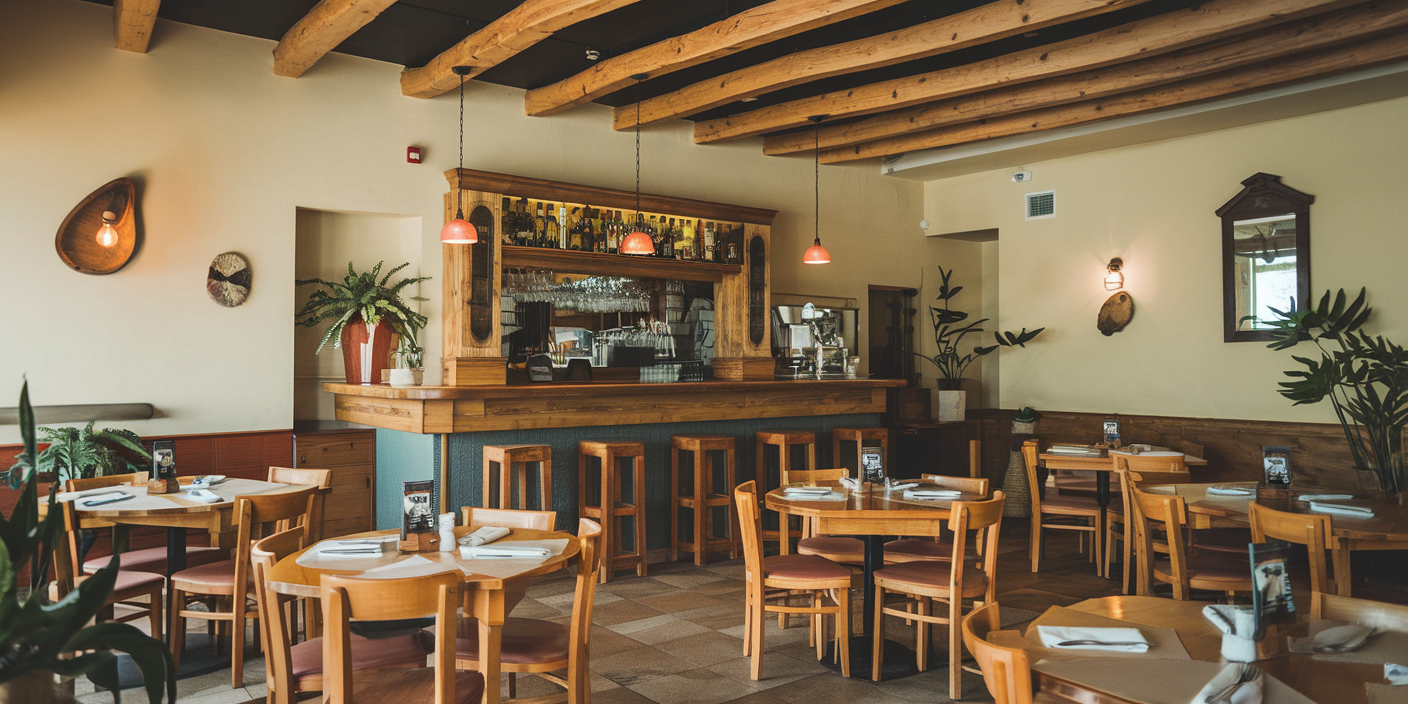Rustic restaurant design continues to captivate diners with its warm, authentic atmosphere that celebrates natural materials and craftsmanship. Whether you’re opening a new establishment or renovating an existing space, rustic design elements can create a memorable dining experience that keeps guests coming back. Let’s explore the essential components of rustic restaurant interiors and how to implement them effectively.



Embracing Natural Materials
The foundation of rustic restaurant design lies in authentic, natural materials that showcase their inherent beauty:
- Reclaimed Wood: Incorporate weathered wooden beams, plank flooring, wall panels, and table tops that tell a story through their patina and grain patterns
- Natural Stone: Use fieldstone, river rock, or local quarried stone for accent walls, fireplaces, or flooring to add texture and regional character
- Exposed Brick: Preserve or install brick walls that provide warmth, texture, and a sense of heritage
- Hammered Metals: Integrate copper, bronze, wrought iron, and tin elements through lighting fixtures, bar tops, and decorative accents
Creating Warm and Inviting Lighting
Lighting sets the mood in a rustic restaurant and should feel warm and intimate:
- Iron Chandeliers: Large, statement pieces with simple designs and Edison bulbs
- Mason Jar Fixtures: Repurposed glass containers as pendant lights
- Lantern-Style Sconces: Wall-mounted fixtures that create pools of warm light
- Candles and Fireplaces: Natural flame elements that create movement and authentic warmth
Selecting Authentic Furniture
Furniture should balance comfort with rustic character:
- Handcrafted Wooden Tables: Solid pieces with visible joinery and natural edges
- Mismatched Vintage Chairs: Create interest with thoughtfully curated seating options
- Leather Upholstery: Incorporate worn leather in booths and banquettes for durability and patina
- Communal Dining Options: Long harvest tables that encourage social interaction
- Built-In Bench Seating: Maximize space while creating cozy nooks
Incorporating Textural Elements
Texture adds depth and interest to rustic spaces:
- Burlap, Linen, and Canvas: Natural fabrics for napkins, table runners, and upholstery
- Woven Elements: Baskets, chair seats, and light fixtures that add handcrafted appeal
- Wool and Hide: Rugs and throws that create warmth and acoustic benefits
- Distressed Finishes: Surfaces with intentional wear that suggest history and use
Adding Thoughtful Décor and Accents
The details bring a rustic restaurant concept to life:
- Antique Tools and Implements: Wall-mounted collections that reference agricultural or culinary heritage
- Botanical Elements: Dried herbs, fresh flowers in simple containers, and potted plants
- Local Artwork: Pieces that reflect regional landscape, wildlife, or cultural traditions
- Open Shelving: Displays of preserved goods, pottery, or serving pieces
- Vintage Signage: Weathered metal or painted wood signs with meaningful messages
Zoning Your Rustic Restaurant Space
Consider creating distinct areas within your restaurant:
- Bar Area: Often featuring a substantial wood or metal bar top with simple, sturdy stools
- Dining Zones: Various seating arrangements to accommodate different group sizes
- Private Dining: Enclosed areas defined by architectural elements like sliding barn doors
- Outdoor Extension: Patios or decks that bring the rustic experience into nature
Balancing Rustic With Modern Functionality
While authentic character is important, modern considerations ensure a successful operation:
- Kitchen Visibility: Open kitchen concepts that showcase culinary craftsmanship
- Acoustic Treatments: Natural materials like reclaimed wood panels that manage sound
- Accessible Layout: Thoughtful floor plans that welcome all guests
- Durable Surfaces: Materials that can withstand commercial use while maintaining character
Regional Variations on Rustic Restaurant Design
Rustic can take different forms depending on local influences:
- Mountain Lodge: Heavy timbers, stone fireplaces, and alpine-inspired elements
- Mediterranean Rustic: Whitewashed walls, terracotta, and wrought iron details
- Farmhouse Style: Shiplap, Windsor chairs, and pastoral references
- Industrial Rustic: Raw concrete, exposed ducting, and repurposed factory elements
Conclusion
A well-executed rustic restaurant interior creates an immediate emotional connection with guests through authenticity, warmth, and attention to detail. By thoughtfully incorporating natural materials, warm lighting, and handcrafted elements, you can create a dining environment that feels both special and comfortable—a place where memories are made and guests long to return.
Remember that the most successful rustic restaurants don’t just look the part—they embody a philosophy of honesty, craftsmanship, and hospitality that extends from the physical space to the service and cuisine.

